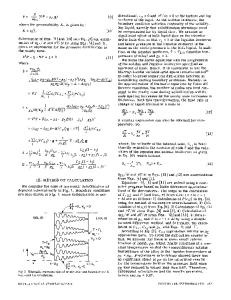Solute distribution around a coherent precipitate in a multicomponent alloy
- PDF / 1,087,154 Bytes
- 12 Pages / 630 x 792 pts Page_size
- 110 Downloads / 309 Views
I.
INTRODUCTION
STRESS fields induced by material defects can influence the equilibrium distribution of solute in crystalline solids. For example, nonuniform distributions of solute atoms are possible in the vicinity of a dislocation I1'2'3[ and inclusions34'5[ Enhancement of the concentration of impurities can have major effects on materials properties; for example, increased solute concentration can initiate the growth of a void I6[ and increase the corrosion rate of an alloy. [71 To obtain the equilibrium solute concentration field in a nonuniformly stressed crystalline solid, both the chemical and mechanical equilibrium conditions must be satisfied at all points in the system. These equilibrium conditions require that in addition to the diffusion potential being uniform throughout the system, ~8[ the stress induced by the nonuniform solute distribution should be accounted for in a self-consistent fashion. Although it is possible to modify the constitutive law to relate the stress to the concentration to account for this stress, Larch6 and Cahn found that this approach does not necessarily yield thermodynamically self-consistent solute concentration fields. Larch6 and Cahn further found that it was possible to determine the equilibrium solute concentration field in a stressed crystalline solid in a simple manner through the use of "open system" elastic constants, t8~ The idea is to modify the usual elastic constants, which are measured at constant composition, to account for both the stress induced by the nonuniform solute field and the effect this redistribution has on the chemical thermodynamics of the
K.C. KING, Research Associate, P.W. VOORHEES, Associate Professor, and G.B. OLSON, Professor, Department of Materials Science and Engineering, and T. MURA, Professor, Department of Civil Engineering, are with Northwestern University, Evanston, IL 60208. Manuscript submitted November 26, 1990. METALLURGICALTRANSACTIONS A
system. Thus, the stresses are determined in the usual fashion via linear elasticity, using the open system elastic constants instead of the usual elastic constants. Larch6 and Cahn have employed this approach to determine the solute distributions in a binary alloy surrounding dislocations tS,9j in the linear elastic approximation and concentration fields in uniaxially stressed nonlinearly elastic solids, tl~ Johnson and Voorhees IX] determined the concentration profiles surrounding two elastically interacting uniformly dilating precipitates in a binary alloy using the open system elastic constant approach. They found that elastic stress induced by those precipitates can induce a significant nonuniform solute concentration. Once the elastic stress has been determined, the composition field follows at once by requiring that the diffusion potential be constant throughout the system. [8[ Since the diffusion potential is related to the usual chemical potentials of the chemical components in the alloy (measured in the absence of stress) and the calculated stress at a point in the solid, it is poss
Data Loading...











